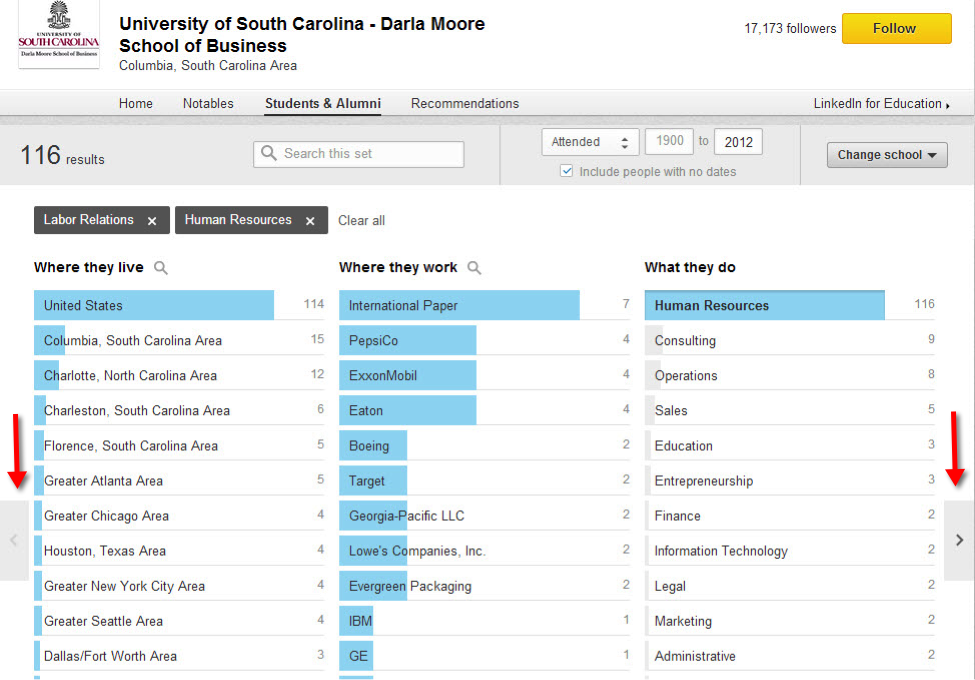2 Tricks that Will Up Your Sourcing Game
As a Sourcing Grandmaster, I am frequently asked to share some strategies or techniques that might help recruiting teams up their sourcing game. In this article, I wanted to give you two techniques that I leverage regularly in my hunt to find additional prospects. These will benefit you because they can be implemented immediately, cost nothing, and may help recruiters like you to be seen as more of sourcing “consultants.”
Trick #1: How to quickly find data on the potential candidate supply
Imagine you are sitting with a hiring manager discussing a new opening or need. You are seeking a HR professional with a Master’s degree specializing in Labor Relations and at least two plus years of experience. You are aware that University of South Carolina has a well-regarded grad program for Labor Relations. The hiring manager asks: ”What does the market look like for this type of role and what other companies have these people?” Can you immediately answer these questions? Could you walk to the hiring manager’s computer and show them right there on the spot?
You can get this data instantly on LinkedIn – you just need to know where to find this information. What’s even better is that LinkedIn is an ideal tool to leverage for instant research/intelligence because the data is actually fresh and frequently updated by the profile owner.
a) Discover and leverage the often overlooked “Education” section
There is an area of LinkedIn that is often overlook and I consider it to be a hidden gem. If you look at the menu bar and under “Interests” choose “Education.” This page is primarily designed to be leveraged for connecting with students or fellow alumni from your alma mater. By typing in the school you desire to focus upon, you can begin to use the various filters to slice and dice the alumni information.
b) Run a targeted search
Based on the hiring manager scenario above, now run a targeted search for people who are grads from a specific school or program. Here’s how:
1) Access the “Education” area, click on “Alumni” and enter your desired target school in “What school did you go to?”
2) Leverage the filtering capabilities. My advice is to do the following:
i. Click on the function you are seeking – for example “Human Resources.” If you do not see what you are looking for, click on “Show More” or “More.”
ii. Click on the “>” icon to the right and reveal more intelligence. In this scenario, I chose “Labor Relations.”
iii. Click on the “<” icon to the left to return to the specific intelligence.
c) Examine your search results of instant research / competitive intelligence
You can see that there are 116 profiles on LinkedIn for people who went to the University of South Carolina and studied Labor Relations or Human Resources. If you are looking for a candidate in Charlotte, you know there are 12 potentials. What companies hire these grads other than PepsiCo? International Paper has seven while Exxon and Eaton each have four.
d) Now for the big reveal…
If you then scroll down to the bottom of the page on LinkedIn, the photos and brief profiles of the matching people are there…actual profiles of graduates. Of course you may not be able to see all of the data and profile information, but if you are a first degree connection of an alum of that school, you have a chance to see most profiles.
Now that you have the “prospect list” of all the grads from a specific Master’s program by company and location, the key is HOW you now use it.
Trick #2 – My “Sit, Source, Remind” technique
In the scenario from Trick#1, we have been seeking a HR professional with 2 years of experience in Labor Relations. University of South Carolina is identified as a good HR grad school and I already have a “list” of the people that graduated after 2012.
The “Sit, Source, Remind” is a technique of actively leveraging targeted research or a “prospect list” (output from the trick above) to gain additional candidates. This is my go-to method for finding top talent. The goal of this sourcing trick is to gain more employee referrals from top employees within my company. Here is how I do it:
SIT:
Identify one or two highly regarded HR employees of YOUR company who graduated from “South Carolina” after 2012. Arrange a face-to-face meeting and SIT down in person.
SOURCE :
At this face-to-face meeting, SOURCE them for additional names by asking “Who do you know that is a good possibility for PepsiCo?” (I am impressed if I get more than one or two names from this question.)
REMIND:
Since asking them “who they know” does not always produce desired results, I show them a print out of my “prospect list” (output from Trick#1). Seeing the names of their old classmates often helps REMIND them of additional people and talent that were not immediately top of mind. Not only are the employees usually impressed that I was able to find such targeted data, but the “prospect list” serves as a great guide for the conversation. We quickly go through the list and try to identify the top talent utilizing a ranking method of “Call now”, “Proceed with questions”, “Do not know”, or “Do not call now.” Based on the “Call now” ranked prospects, my typical outreach method is direct outreach via phone. NO E-MAIL! I always try to get the employee that gave me the positive feedback to say it is OK to use their name as a referral when calling their grad school acquaintance. This turns the outreach into more of a “warm call” versus a “cold call” since I am able to say something like “John Smith recommended that I call you…”
Benefits of these tricks:
Hopefully this blog post has shown you how to quickly gather information from LinkedIn and leverage that research to produce additional leads. Personally, I have found by combining these two zero-cost tricks into an overall strategy has helped me to increase my candidate flow by 20% in most cases. The bigger overarching benefit of implementing these tricks are the increased perception of being seen as more of a “consultative” partner because you are bringing data and “new” information to your partners in the recruiting process.
Happy hunting!
Topics: Sourcing Passive candidate recruiting
Related articles






